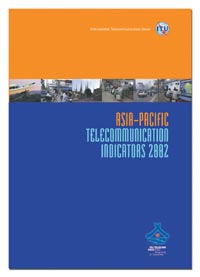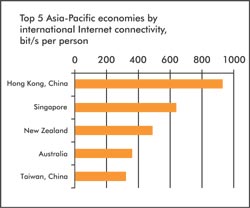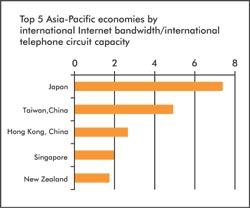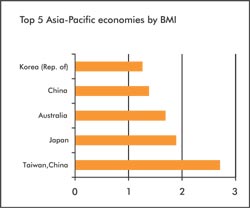Measuring international Internet bandwidth
How can the sufficiency of a nationís international Internet capacity be
measured? This article highlights four ways.
 Raw quantity or the amount of international Internet bandwidth adjusted by
population. Hong Kong, China ranks top in this indicator with almost 1000
bit/s of bandwidth per inhabitant (see figure below). However, per capita
bandwidth may not be meaningful because countries have different levels of
Internet penetration. Therefore even if a nationís per capita bandwidth is
low, it may have enough given the number of Internet users in the country. Since
Internet use tends to be related to income, this indicator might be adjusted by
per capita income to indicate if a nation is doing well relative to its per
capita income. Raw quantity or the amount of international Internet bandwidth adjusted by
population. Hong Kong, China ranks top in this indicator with almost 1000
bit/s of bandwidth per inhabitant (see figure below). However, per capita
bandwidth may not be meaningful because countries have different levels of
Internet penetration. Therefore even if a nationís per capita bandwidth is
low, it may have enough given the number of Internet users in the country. Since
Internet use tends to be related to income, this indicator might be adjusted by
per capita income to indicate if a nation is doing well relative to its per
capita income.
 Quality related to bandwidth per subscriber. It is computed by
dividing the international Internet capacity by the number of Internet
subscribers. Available evidence suggests that some 256 kbit/s per subscriber is
a yardstick for the amount of international bandwidth per subscriber.1 Interestingly,
the Maldives, a least developed country, ranks first in this indicator with some
409 kbit/s of international Internet bandwidth per subscriber. However, this
indicator can be misleading for a number of reasons. ISPs might tailor
international bandwidth just to the existing number of subscribers, constraining
addition of new ones. In some countries, the number of users may be
significantly higher than subscribers because of public Internet access. Thus
the overall Internet experience may be a poor one. Furthermore, the growing
deployment of broadband Internet access requires that users have greater
international bandwidth. Quality related to bandwidth per subscriber. It is computed by
dividing the international Internet capacity by the number of Internet
subscribers. Available evidence suggests that some 256 kbit/s per subscriber is
a yardstick for the amount of international bandwidth per subscriber.1 Interestingly,
the Maldives, a least developed country, ranks first in this indicator with some
409 kbit/s of international Internet bandwidth per subscriber. However, this
indicator can be misleading for a number of reasons. ISPs might tailor
international bandwidth just to the existing number of subscribers, constraining
addition of new ones. In some countries, the number of users may be
significantly higher than subscribers because of public Internet access. Thus
the overall Internet experience may be a poor one. Furthermore, the growing
deployment of broadband Internet access requires that users have greater
international bandwidth.
 Internet economy transition indicator. It is calculated by dividing
the amount of international Internet capacity by equivalent voice satellite and
submarine circuits (circuits multiplied by 64 kbit/s). This measures if the
economy has more Internet than voice telephony circuits, suggesting that
Internet dominates international communication. Japan leads in this category
with roughly seven times more international Internet capacity than voice
telephone circuits. Around ten economies in the region have made the transition.
A high value for this indicator also suggests that a nation has moved to a sustainable telecommunication sector because it is not so concerned about
applications such as Internet telephony cutting into conventional
circuit-switched revenues. Internet economy transition indicator. It is calculated by dividing
the amount of international Internet capacity by equivalent voice satellite and
submarine circuits (circuits multiplied by 64 kbit/s). This measures if the
economy has more Internet than voice telephony circuits, suggesting that
Internet dominates international communication. Japan leads in this category
with roughly seven times more international Internet capacity than voice
telephone circuits. Around ten economies in the region have made the transition.
A high value for this indicator also suggests that a nation has moved to a sustainable telecommunication sector because it is not so concerned about
applications such as Internet telephony cutting into conventional
circuit-switched revenues.
 Estimated demand. A Bit-Minute Index or BMI (formulated by the
research company TeleGeography) can be constructed based on the theory that
demand for international telephone conversations is a proxy for Internet
communications. For example, the Internet can be used for voice over Internet
Protocol and electronic mail to substitute for conventional circuit-switched
telephone calls. BMI is constructed by dividing the total of incoming and
outgoing international telephone calls (measured in minutes) by the
international Internet bandwidth. Taiwan, China ranks first in this indicator.
However, BMI is not a perfect substitute for estimating hidden Internet demand.
Use of the Internet requires considerably extra skills and is more complicated
than making a telephone call so that even if there was substantially extra
international Internet bandwidth it is not clear if a nation could use it
without the requisite skills. Estimated demand. A Bit-Minute Index or BMI (formulated by the
research company TeleGeography) can be constructed based on the theory that
demand for international telephone conversations is a proxy for Internet
communications. For example, the Internet can be used for voice over Internet
Protocol and electronic mail to substitute for conventional circuit-switched
telephone calls. BMI is constructed by dividing the total of incoming and
outgoing international telephone calls (measured in minutes) by the
international Internet bandwidth. Taiwan, China ranks first in this indicator.
However, BMI is not a perfect substitute for estimating hidden Internet demand.
Use of the Internet requires considerably extra skills and is more complicated
than making a telephone call so that even if there was substantially extra
international Internet bandwidth it is not clear if a nation could use it
without the requisite skills.
 One measure alone is not adequate to give an overall picture of how a nation
is fairing in its international Internet capacity. Using a composite weighting
all four indicators equally would find Hong Kong, China ranked first followed by
Taiwan, China, Singapore, Australia and Japan. One measure alone is not adequate to give an overall picture of how a nation
is fairing in its international Internet capacity. Using a composite weighting
all four indicators equally would find Hong Kong, China ranked first followed by
Taiwan, China, Singapore, Australia and Japan.
|
1 See
ISP Planet "Pricing your services".
|
|